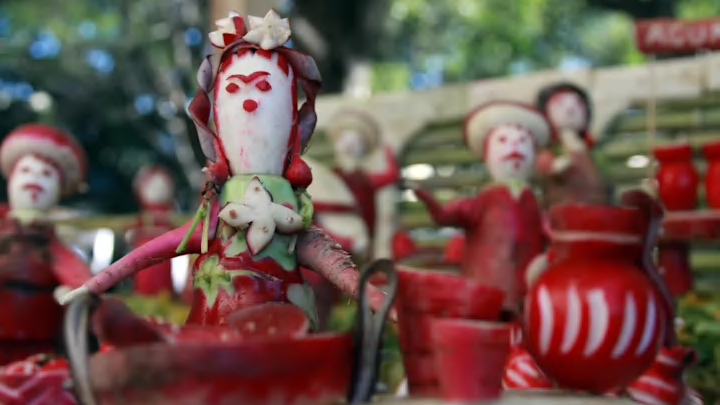The fantastically-shaped radish sculptures of La Noche de los Rabanos are the centerpiece of a major cultural event.
Located in the south-central part of Mexico, the city of Oaxaca de Juárez has been home to a unique December festival for over a century. Now a major cultural event that draws tourists from far and wide, La Noche de los Rabanos—the Night of the Radishes—began hundreds of years ago from humble roots, when the native farmers were given a new challenge.

Back in the 16th century, when the Spanish were colonizing the coasts of North America, they brought a variety of nonindigenous plants along with them. One such plant was the humble radish, which was found to thrive particularly well in the area we now call Mexico.

Once radishes had been introduced to the region, legend has it that Spanish monks began encouraging the local Zapotec and Mixtec people, among other indigenous groups in and around the city of Oaxaca, to cultivate the easy-to-grow veggie as a food crop.

The Oaxacan people have a long history of woodcarving, traditionally making ornate masks, tools, and figurines, and so the region’s woodworkers quickly began applying their skill sets to the radishes, creating elaborate, beautiful art. At first, these carvings were used as a gimmick to lure customers in at the town’s produce markets. (Image credit: Drew Leavy, Flickr // CC BY-SA 2.0)

Soon, the Oaxacans began intentionally leaving radishes in the ground long past their prime so that they’d grow into strange shapes and enormous sizes. Eventually, it became a Oaxacan tradition to harvest the huge, colorful rabanos in time for the Christmas Market on December 23 and carve them up to decorate both market stalls and holiday dinner tables. (Image credit: AlejandroLinaresGarcia, Wikimedia Commons // CC BY-SA 4.0)

By 1897, the mayor of the city of Oaxaca, Francisco Vasconcelos Flores, declared a radish-carving contest in the town’s zocálo (main plaza) on December 23. All the little red people, animals, monsters, flowers, churches, and other creations were displayed in public amid a special fiesta held for the occasion. (Image credit: AlejandroLinaresGarcia, Wikimedia // CC BY-SA 4.0)

Today, 120 years later, the festival continues on December 23 of each year, with cash prizes going to the most talented radish-carvers, who are judged on the beauty, technical skill, and creativity of their creations. The modern rendition of La Noche de los Rabanos also includes contests for art made from flowers and corn husks, and the plaza is crowded with street food vendors, onlookers, competitors, and breakdancing Santas, among other characters. (Image credit: AlejandroLinaresGarcia, Wikimedia // CC BY-SA 4.0)

The next night brings a parade for Christmas Eve, and two days later, the city of Oaxaca throws a serious fiesta on Christmas Day, which entails dancing, fireworks, and a massive Christmas feast. (Image credit: Steve Cadman, Flickr // CC BY-SA 2.0)

Drew Leavy, Flickr//CC BY-NC-ND 2.0
